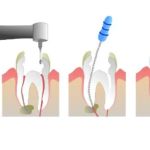How to Prevent and Treat Periodontal Pockets
- 1. Understanding Periodontal Pockets
- 2. Causes of Periodontal Pockets
- 3. Signs of Periodontal Pockets
- 4. Prevention Tips for Periodontal Pockets
- 5. Treatment Options for Periodontal Pockets
- 6. Real-Life Case: Managing Periodontal Pockets
- 7. Take Action: Protect Your Gums and Teeth
1. Understanding Periodontal Pockets
Periodontal pockets are spaces that form between the gums and teeth as a result of gum disease (periodontitis). These pockets develop when plaque and tartar build up beneath the gumline, leading to inflammation, infection, and the eventual separation of the gum tissue from the teeth. When left untreated, periodontal pockets can deepen, causing further damage to the tooth and bone structure, which can lead to tooth loss.
2. Causes of Periodontal Pockets
Periodontal pockets are caused by the progression of gum disease, which begins with gingivitis. If gingivitis is not treated, it can develop into periodontitis, leading to the formation of these pockets. Common causes of periodontal pockets include:
- Poor Oral Hygiene: Inadequate brushing and flossing allow plaque to accumulate along the gumline, which eventually hardens into tartar.
- Smoking or Tobacco Use: Tobacco use weakens the immune system and makes it harder for gums to heal, increasing the risk of periodontal disease.
- Genetics: Some individuals may be more genetically predisposed to gum disease and the formation of periodontal pockets.
- Hormonal Changes: Pregnancy, menopause, and other hormonal changes can make gums more sensitive and prone to infection.
- Other Medical Conditions: Conditions such as diabetes and certain medications can increase the risk of gum disease and the formation of periodontal pockets.
3. Signs of Periodontal Pockets
Periodontal pockets often do not cause pain in the early stages, but there are several signs to look out for:
- Bleeding Gums: Gums that bleed when brushing or flossing are a common sign of gum disease and periodontal pockets.
- Swollen or Red Gums: Inflamed gums that are tender to the touch or appear swollen and red can indicate the presence of periodontal pockets.
- Bad Breath: Persistent bad breath or a bad taste in the mouth can be caused by the bacteria in periodontal pockets.
- Loose Teeth: As periodontal pockets deepen, they can cause the teeth to become loose or shift in the mouth.
- Receding Gums: The gums may start to pull away from the teeth, exposing more of the tooth’s surface or the tooth’s roots.
4. Prevention Tips for Periodontal Pockets
Preventing the formation of periodontal pockets is possible with good oral hygiene and regular dental care. Some helpful prevention tips include:
- Brush and Floss Regularly: Brush your teeth at least twice a day with fluoride toothpaste and floss once daily to remove plaque from the gumline and between your teeth.
- Visit Your Dentist Regularly: Regular dental checkups and professional cleanings help catch any signs of gum disease early and prevent the formation of periodontal pockets.
- Quit Smoking: Stopping smoking can significantly reduce the risk of gum disease and improve overall gum health.
- Maintain a Healthy Diet: A balanced diet that includes vitamins and minerals, such as vitamin C, supports healthy gums and immune function.
- Use Antibacterial Mouthwash: Mouthwashes containing antibacterial agents can help reduce plaque buildup and bacteria around the gumline.
5. Treatment Options for Periodontal Pockets
If periodontal pockets have formed, prompt treatment is essential to prevent further damage. Depending on the severity, treatment options may include:
- Scaling and Root Planing: This non-surgical procedure involves deep cleaning the teeth and smoothing the root surfaces to remove plaque and tartar from below the gumline.
- Antibiotics: Topical or oral antibiotics may be prescribed to help control infection and reduce inflammation in the gums.
- Laser Therapy: Laser treatments can help remove bacteria and infected tissue from periodontal pockets, promoting healing and gum reattachment.
- Surgical Treatment: In advanced cases, surgical procedures may be needed to reduce pocket depth, restore gum tissue, or regenerate lost bone.
6. Real-Life Case: Managing Periodontal Pockets
Consider the case of Rachel, a 45-year-old woman who noticed her gums bleeding and swelling around her molars. After a dental examination, she was diagnosed with periodontal pockets in several areas of her mouth. Her dentist performed scaling and root planing, followed by the use of an antibacterial mouthwash. After several months of diligent oral care, Rachel’s gums healed, and the pockets significantly reduced in depth. Her story highlights the importance of early detection and prompt treatment in managing periodontal pockets effectively.
7. Take Action: Protect Your Gums and Teeth
Preventing and treating periodontal pockets is crucial for maintaining overall dental health. By following good oral hygiene practices, visiting your dentist regularly, and addressing any signs of gum disease early, you can protect your teeth and gums from further damage. For expert advice on maintaining gum health and preventing periodontal pockets, visit Dentistry Toothtruth for more information on the best oral care products and treatments.







 Simply Beautiful Smiles of Abington, PA4.0 (142 review)
Simply Beautiful Smiles of Abington, PA4.0 (142 review) Ramsey Family Dental5.0 (93 review)
Ramsey Family Dental5.0 (93 review) Maple Drive Dentistry4.0 (207 review)
Maple Drive Dentistry4.0 (207 review) Dr. Steven R. Hart, DDS Devon Dental Associates0.0 (0 review)
Dr. Steven R. Hart, DDS Devon Dental Associates0.0 (0 review) Mundelein Dental Center3.0 (8 review)
Mundelein Dental Center3.0 (8 review) Compassionate Dental Care5.0 (34 review)
Compassionate Dental Care5.0 (34 review) The Importance of Oral Health Education During Pregnancy for a Healthy Pregnancy
The Importance of Oral Health Education During Pregnancy for a Healthy Pregnancy Best Tips for Brushing Your Teeth Properly for Healthy Gums: Essential Techniques for Oral Health
Best Tips for Brushing Your Teeth Properly for Healthy Gums: Essential Techniques for Oral Health Why Skipping Dental Checkups Can Lead to Bigger Oral Health Problems
Why Skipping Dental Checkups Can Lead to Bigger Oral Health Problems Advantages of Porcelain Dental Restorations
Advantages of Porcelain Dental Restorations How Can Diabetes Cause Tooth and Gum Problems? Preventing and Managing Oral Health Issues
How Can Diabetes Cause Tooth and Gum Problems? Preventing and Managing Oral Health Issues Healthy Habits for Promoting Good Oral Health and Hygiene: Tips for a Healthy Smile
Healthy Habits for Promoting Good Oral Health and Hygiene: Tips for a Healthy Smile